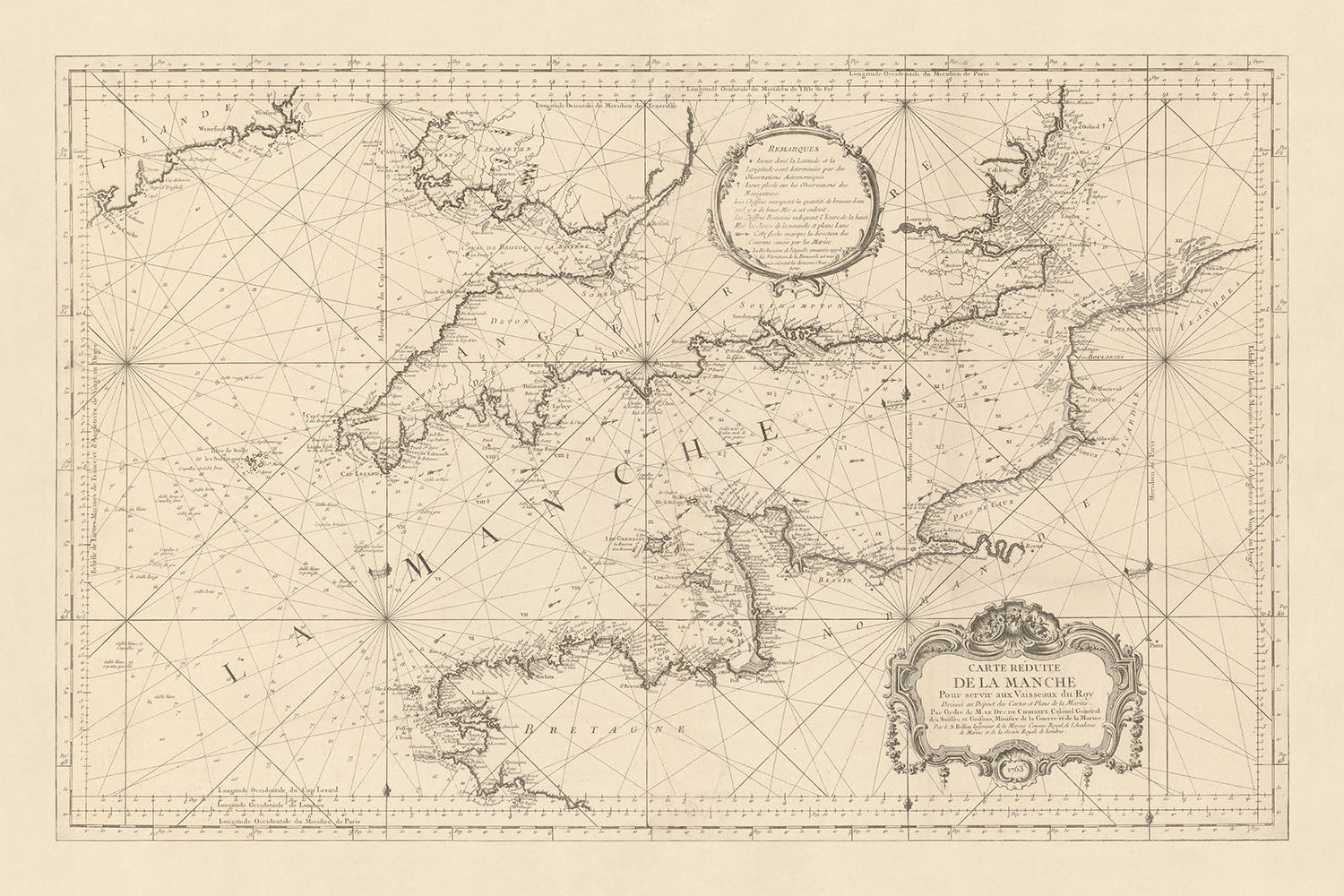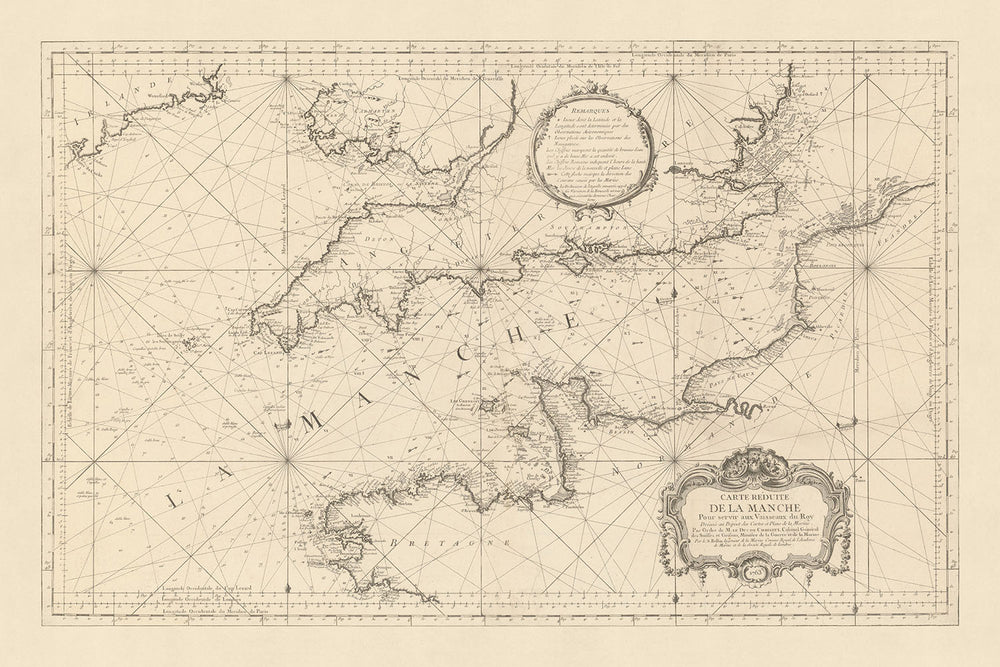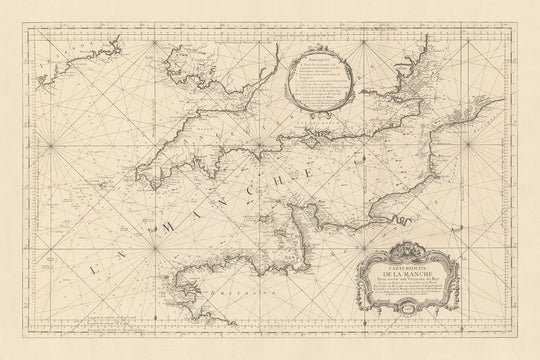- Handmade locally. No import duty or tax
- FREE Delivery by Christmas
- Love it or your money back (90 days)
- Questions? WhatsApp me any time
Own a piece of history
5,000+ 5 star reviews


Embark on a historical voyage with the "Carte Réduite de la Manche," a masterpiece crafted by the renowned French cartographer Jacques Bellin in 1763. Bellin, esteemed for his precision and artistry, served as the Hydrographer to the King of France, a position that underscored his expertise in creating navigational charts. This particular chart, a testament to Bellin's skill, was designed during the tumultuous times of the Seven Years' War, a period marked by global conflict and the struggle for supremacy between France and Great Britain. The map's creation was likely motivated by the need to aid the French Navy in navigating the treacherous waters of the English Channel, or La Manche, during this era of maritime warfare and exploration.
The "Carte Réduite de la Manche" is not merely a navigational tool but a historical document that offers a window into the 18th-century geopolitical landscape. It meticulously outlines the southern coast of the British Isles and the northern coast of France, highlighting only the coastal towns, including the bustling capitals of London and Paris. The map is further enriched by the labeling of key counties and regions such as Sussex, Dorset, Devon, Cornwall, Normandy, Brittany, Picardy, and Flanders. This careful selection of details provides insight into the areas of strategic and navigational importance during a time when control of the seas was pivotal to national power and colonial expansion.
The chart is a visual feast, adorned with a compass rose and a fleur-de-lis, symbols that not only serve a practical purpose but also add to the aesthetic appeal of the map. The orientation with north at the top and the inclusion of detailed geographic features such as the English Channel, the Atlantic Ocean, the North Sea, the Irish Sea, and the Bay of Biscay, along with significant borders, mountains, and bodies of water, make this map a comprehensive guide for sailors of the time. Noteworthy landmarks such as the Isle of Wight, the Isle of Man, and iconic lighthouses like the Eddystone, Bishop Rock, and Fastnet Rock Lighthouses are meticulously marked, showcasing the map's utility and attention to detail.
The inclusion of cities and towns on this map, from the major metropolises of London and Paris to the strategic ports of Plymouth, Portsmouth, and Le Havre, reveals the economic and military significance of these locations during the 18th century. The map also highlights lesser-known but equally important coastal towns and regions, providing a glimpse into the vibrant local economies and cultures that thrived along the shores of the English Channel. This level of detail not only aids in navigation but also serves as a historical record of the bustling life along these coasts during a time of great international rivalry and cooperation.
In essence, the "Carte Réduite de la Manche" by Jacques Bellin is more than just a map; it is a historical artifact that captures the complexity of 18th-century maritime navigation, warfare, and diplomacy. Its creation during the Seven Years' War, a conflict that reshaped the world's political and colonial landscape, imbues it with historical significance. For collectors, historians, and aficionados of cartography, this map is a luxurious glimpse into a bygone era, offering both aesthetic beauty and a rich tapestry of historical narratives waiting to be explored.
Cities and towns on this map
- England
- London (8,982,000)
- Plymouth (264,000)
- Portsmouth (205,400)
- Southampton (253,600)
- Brighton (273,400)
- Hastings (97,500)
- Dover (39,100)
- Folkestone (52,900)
- Margate (60,400)
- Ramsgate (40,400)
- Sheerness (54,400)
- Southend-on-Sea (183,000)
- France
- Paris (2,206,488)
- Le Havre (178,995)
- Rouen (110,755)
- Caen (107,229)
- Cherbourg (80,162)
- Saint-Malo (46,184)
- Granville (12,943)
- Avranches (7,976)
- Dieppe (31,962)
- Fécamp (19,583)
- Boulogne-sur-Mer (40,397)
- Calais (72,944)
- Dunkerque (91,386)
- Other
- Saint Helier, Jersey (33,500)
- Saint Peter Port, Guernsey (18,200)
Notable Features & Landmarks
- Inset maps:
- A map of the Channel Islands
- A map of the Scilly Isles
- Bodies of water:
- The English Channel
- The Atlantic Ocean
- The North Sea
- The Irish Sea
- The Bay of Biscay
- Borders:
- The border between England and France
- The border between England and Wales
- The border between England and Scotland
- The border between Ireland and Northern Ireland
- Mountains:
- The Cheviot Hills
- The Pennines
- The Cambrian Mountains
- The Black Mountains
- The Mourne Mountains
- Other notable features:
- The Isle of Wight
- The Isle of Man
- The Eddystone Lighthouse
- The Bishop Rock Lighthouse
- The Fastnet Rock Lighthouse
Historical and design context
- Title: Carte Réduite de la Manche
- Date: 1763
- Mapmaker: Jacques Bellin
- Topics: This is a Country Naval Chart.
- Geographic coverage: The map covers all of the southern coast of the British Isles, and the northern coast of France. Only coastal towns are labelled, along with London and Paris. Some counties/regions are labelled, such as Sussex, Dorset, Devon, Cornwall, Normandy, Brittany, Picardy, and Flanders.
- Design: The map is a hand-drawn, colored map. It is oriented with north at the top. The map is decorated with a compass rose and a fleur-de-lis.
- Historical context: This map was made during the Seven Years' War (1756-1763). The war was fought between Great Britain and France, and their respective allies. The war was fought over a number of issues, including control of the North American colonies and the Caribbean. The map was likely made to help the French Navy navigate the English Channel during the war.
Please double check the images to make sure that a specific town or place is shown on this map. You can also get in touch and ask us to check the map for you.
This map looks great at every size, but I always recommend going for a larger size if you have space. That way you can easily make out all of the details.
This map looks amazing at sizes all the way up to 70in (180cm). If you are looking for a larger map, please get in touch.
Please note: the labels on this map are hard to read if you order a map that is 16in (40cm) or smaller. The map is still very attractive, but if you would like to read the map easily, please buy a larger size.
The model in the listing images is holding the 24x36in (60x90cm) version of this map.
The fifth listing image shows an example of my map personalisation service.
If you’re looking for something slightly different, check out my collection of the best old maps to see if something else catches your eye.
Please contact me to check if a certain location, landmark or feature is shown on this map.
This would make a wonderful birthday, Christmas, Father's Day, work leaving, anniversary or housewarming gift for someone from the areas covered by this map.
This map is available as a giclée print on acid free archival matte paper, or you can buy it framed. The frame is a nice, simple black frame that suits most aesthetics. Please get in touch if you'd like a different frame colour or material. My frames are glazed with super-clear museum-grade acrylic (perspex/acrylite), which is significantly less reflective than glass, safer, and will always arrive in perfect condition.
This map is also available as a float framed canvas, sometimes known as a shadow gap framed canvas or canvas floater. The map is printed on artist's cotton canvas and then stretched over a handmade box frame. We then "float" the canvas inside a wooden frame, which is available in a range of colours (black, dark brown, oak, antique gold and white). This is a wonderful way to present a map without glazing in front. See some examples of float framed canvas maps and explore the differences between my different finishes.
For something truly unique, this map is also available in "Unique 3D", our trademarked process that dramatically transforms the map so that it has a wonderful sense of depth. We combine the original map with detailed topography and elevation data, so that mountains and the terrain really "pop". For more info and examples of 3D maps, check my Unique 3D page.
For most orders, delivery time is about 3 working days. Personalised and customised products take longer, as I have to do the personalisation and send it to you for approval, which usually takes 1 or 2 days.
Please note that very large framed orders usually take longer to make and deliver.
If you need your order to arrive by a certain date, please contact me before you order so that we can find the best way of making sure you get your order in time.
I print and frame maps and artwork in 23 countries around the world. This means your order will be made locally, which cuts down on delivery time and ensures that it won't be damaged during delivery. You'll never pay customs or import duty, and we'll put less CO2 into the air.
All of my maps and art prints are well packaged and sent in a rugged tube if unframed, or surrounded by foam if framed.
I try to send out all orders within 1 or 2 days of receiving your order, though some products (like face masks, mugs and tote bags) can take longer to make.
If you select Express Delivery at checkout your order we will prioritise your order and send it out by 1-day courier (Fedex, DHL, UPS, Parcelforce).
Next Day delivery is also available in some countries (US, UK, Singapore, UAE) but please try to order early in the day so that we can get it sent out on time.
My standard frame is a gallery style black ash hardwood frame. It is simple and quite modern looking. My standard frame is around 20mm (0.8in) wide.
I use super-clear acrylic (perspex/acrylite) for the frame glass. It's lighter and safer than glass - and it looks better, as the reflectivity is lower.
Six standard frame colours are available for free (black, dark brown, dark grey, oak, white and antique gold). Custom framing and mounting/matting is available if you're looking for something else.
Most maps, art and illustrations are also available as a framed canvas. We use matte (not shiny) cotton canvas, stretch it over a sustainably sourced box wood frame, and then 'float' the piece within a wood frame. The end result is quite beautiful, and there's no glazing to get in the way.
All frames are provided "ready to hang", with either a string or brackets on the back. Very large frames will have heavy duty hanging plates and/or a mounting baton. If you have any questions, please get in touch.
See some examples of my framed maps and framed canvas maps.
Alternatively, I can also supply old maps and artwork on canvas, foam board, cotton rag and other materials.
If you want to frame your map or artwork yourself, please read my size guide first.
My maps are extremely high quality reproductions of original maps.
I source original, rare maps from libraries, auction houses and private collections around the world, restore them at my London workshop, and then use specialist giclée inks and printers to create beautiful maps that look even better than the original.
My maps are printed on acid-free archival matte (not glossy) paper that feels very high quality and almost like card. In technical terms the paper weight/thickness is 10mil/200gsm. It's perfect for framing.
I print with Epson ultrachrome giclée UV fade resistant pigment inks - some of the best inks you can find.
I can also make maps on canvas, cotton rag and other exotic materials.
Learn more about The Unique Maps Co.
Map personalisation
If you're looking for the perfect anniversary or housewarming gift, I can personalise your map to make it truly unique. For example, I can add a short message, or highlight an important location, or add your family's coat of arms.
The options are almost infinite. Please see my map personalisation page for some wonderful examples of what's possible.
To order a personalised map, select "personalise your map" before adding it to your basket.
Get in touch if you're looking for more complex customisations and personalisations.
Map ageing
I have been asked hundreds of times over the years by customers if they could buy a map that looks even older.
Well, now you can, by selecting Aged before you add a map to your basket.
All the product photos you see on this page show the map in its Original form. This is what the map looks like today.
If you select Aged, I will age your map by hand, using a special and unique process developed through years of studying old maps, talking to researchers to understand the chemistry of aging paper, and of course... lots of practice!
If you're unsure, stick to the Original colour of the map. If you want something a bit darker and older looking, go for Aged.
If you are not happy with your order for any reason, contact me and I'll get it fixed ASAP, free of charge. Please see my returns and refund policy for more information.
I am very confident you will like your restored map or art print. I have been doing this since 1984. I'm a 5-star Etsy seller. I have sold tens of thousands of maps and art prints and have over 5,000 real 5-star reviews. My work has been featured in interior design magazines, on the BBC, and on the walls of dozens of 5-star hotels.
I use a unique process to restore maps and artwork that is massively time consuming and labour intensive. Hunting down the original maps and illustrations can take months. I use state of the art and eye-wateringly expensive technology to scan and restore them. As a result, I guarantee my maps and art prints are a cut above the rest. I stand by my products and will always make sure you're 100% happy with what you receive.
Almost all of my maps and art prints look amazing at large sizes (200cm, 6.5ft+) and I can frame and deliver them to you as well, via special oversized courier. Contact me to discuss your specific needs.
Or try searching for something!















































